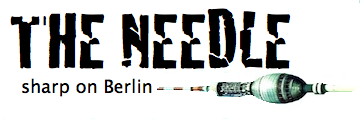Blaming Hipsters for Gentrification in Neukölln?
Imagine you are in a Berlin bar, at your most vulnerable at the urinal or bathroom stall, and you read the sticker above, posted on the wall. What is your first reaction? Mine was, “Wow. Were the creators of this sticker taking drugs when they made it? Or just incredibly ignorant of their own history?” I’ve seen it posted all over Kreuzberg bars and clubs over the last six months and am astonished every time I come across it. It’s only recently (and thanks to a Needle reader) that I have a better insight into its creators and understand that the sticker is meant to be ironic. The problem is that at first glance it is not.
Let’s start with a translation: “…more bars, more wireless, more organic markets…Tourists, hipsters, rich southern Germans (Schwaben), Hipster-antifa… Everyone is Welcome. Party Like it’s 1945”. And then there’s a logo and flag: of the “Antifascists”.
The sticker can be read as an expression of the left-wing critique of gentrification––scapegoating tourists and foreigners for rising rents–– that has made the international news. The argument goes as follows: rich southern Germans and hipsters (often North American) move to the relatively inexpensive city of Berlin, bring up the rents, introduce their bourgeois tastes, destroy the local character… a veritable invasion! Here, they are compared to Allied soldiers and told they are “welcome”.
Hello?
The Allied soldiers in the picture are living it up like the new arrivals in Berlin today. Berlin is in ruins, a conquered city. The problem is that by objecting to soldiers (first Soviets then Western) arriving in 1945, one is objecting to the Nazis losing the war!
This sticker makes me feel 1. surrounded by some very murky xenophobia in Berlin, and 2. proud to be a North American anti-fascist newish arrival who uses wifi, shops organic, and raises a glass over the ruins of Berlin! I think someone should pour me some Sekt now and start singing Lili Marlene!
But read on:
Our Needle reader Südberlin has provided some important contextualisation in a comment (see the comments section after this post). It makes clear that this sticker is full of contradictions that make it a hermeneutical-historical theorist’s wet dream.
The group that produced the stickers is called Hipster Antifa Neukölln. They have a Facebook site and are organising events at the social-activist pub Laidak.
Who knows what will really come out of their discussions of “left-wing hate of tourists” this December. (Their abstract is dense and dialectical. On one hand, it criticises the international press’s solidarity with tourists saying it overlooks”the unedifying presence” of the “post-modern bohemian hip” freelancer who is a “caricature of a world citizenship”, and the product of the dislocation of humanity decried by Adorno. On the other hand, it characterises the reaction against tourists as a regressive form of capitalist critique and left-romantic nostalgia for neighbourhood purity). The position of the Antifascists is clarified in their mission statement. They object to hipsters, newcomers and tourists being blamed for the rise in rents and the “decomposition” of the “original neighbourhood”. They object to the xenophobia of the anti-gentrification critique. They say that they have adopted a “highly nuanced position” that rejects discrimination and resentment across the board, including verbal and physical attacks on those identified as a “hipsters” or “tourists” or other neighbourhood cash cows who are changing (esp.) Neukölln’s character. Fantastic!
The problem is that the position is very nuanced indeed. Any historically-aware reader of these stickers is likely to feel alienated, in particular because he or she has no access to the context of their production. A critical but occasional reader, like myself, is likely to think that they were created 1. either by the rhetorically confused or, 2. by xenophobic fascists at large in their neighbourhood.
The latter, with an ironic twist, is no doubt the Antifascist’s point. The former is its unintended effect.


I am afraid that part of the discussion is missing here: these stickers were introduced in the scene by Hipster Antifa Neukölln (their only official presence is https://www.facebook.com/hipsterantifa, but there are several articles in berlin-based german newspapers). They complain about the xenophobia and hate which the gentrification debate brought along. They’ll host two events in december in Neukölln – https://www.facebook.com/events/304839896288423/.
To sum it up: They don’t complain about people coming to Berlin, they complain about the xenophobia of people already in Berlin who hate on “tourists” and “hipsters”.
maybe the hipster-antifa being un-ironic is some sort of meta-irony.
Dear Südberliner, Thanks so much for the clarification. I was completely puzzled by these stickers. It’s a shame they need contextualisation to make sense. I will revise the post above and mention your important comment. Thank you very much! Joseph
Thanks for this text and the clarification. Just one thought on the subject of those posters: anything that requires a lengthy explanation, plenty of background, etc. is already a borderline case.
Anything that requires a lengthy explanation, plenty of background AND uses WW2 as its chief motive while operating in Berlin is just plain wrong.
I´m all for irony and wink-wink approach but in the case of this poster it just doesn´t work. Worse, I find it pretty offending.
The thing with irony is it has to tread lightly. This puts the boot down with a stomp.
Thanks Notmsparker! Agreed!
A side-note: The Guardian took an interest in this story two days after I published my post…
http://www.guardian.co.uk/travel/2012/dec/04/berlin-fights-anti-hipster-tourism-abuse
I wonder if they read The Needle?
Joseph
You’re welcome 🙂